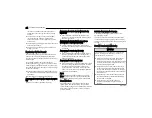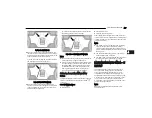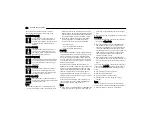
3. Insert the fuel nozzle fully into the filler pipe, the
nozzle opens and holds both flapper doors while
refueling.
Fuel Filler
4. When the fuel nozzle “clicks” or shuts off, the fuel
tank is full.
5. Keep the nozzle in the filler for five seconds after
nozzle clicks to allow fuel to drain from the nozzle.
6. Remove the fuel filler nozzle.
7.
To close the fuel filler door, push the center-rear
edge (3 o’clock position) of the fuel filler door and
then release. The fuel filler door will latch closed.
NOTE:
In certain cold conditions, ice may prevent the fuel filler
door from opening. If this occurs, lightly push on the
fuel filler door around the perimeter to break the ice
buildup.
WARNING!
Static electricity can cause an ignition of flammable
liquid, vapor or gas in any vehicle or trailer. To reduce
risk of serious injury or death when filling containers:
●
Always place container on the ground before filling.
●
Keep the pump nozzle in contact with the
container when you are filling it.
●
Use only approved containers for flammable liquid.
●
Do not leave container unattended while filling.
●
A static electric charge could cause a spark and
fire hazard.
VEHICLE LOADING
C
ERTIFICATION
L
ABEL
As required by National Highway Traffic Safety
Administration regulations, your vehicle has a
certification label affixed to the driver's side door or
B-pillar.
This label contains the month and year of manufacture,
Gross Vehicle Weight Rating (GVWR), front and
rear Gross Axle Weight Rating (GAWR), and Vehicle
Identification Number (VIN). A Month-Day-Hour (MDH)
number is included on this label and indicates the
Month, Day and Hour of manufacture. The bar code
that appears on the bottom of the label is your VIN.
Gross Vehicle Weight Rating (GVWR)
The GVWR is the total permissible weight of your vehicle
including driver, passengers, vehicle, options and cargo.
The label also specifies maximum capacities of front
and rear GAWR. Total load must be limited so GVWR
and front and rear GAWR are not exceeded.
Payload
The payload of a vehicle is defined as the allowable
load weight a truck can carry, including the weight of
the driver, all passengers, options and cargo.
Gross Axle Weight Rating (GAWR)
The GAWR is the maximum permissible load on the
front and rear axles. The load must be distributed in
the cargo area so that the GAWR of each axle is not
exceeded.
Each axle GAWR is determined by the components in
the system with the lowest load carrying capacity (axle,
springs, tires or wheels). Heavier axles, or suspension
components sometimes specified by purchasers for
increased durability, do not necessarily increase the
vehicle's GVWR.
Tire Size
The tire size on the Vehicle Certification Label
represents the actual tire size on your vehicle.
Replacement tires must be equal to the load capacity
of this tire size.
Rim Size
This is the rim size that is appropriate for the tire size
listed.
Inflation Pressure
This is the cold tire inflation pressure for your vehicle
for all loading conditions up to full Gross Axle Weight
Rating (GAWR).
STARTING AND OPERATING 185
4







































